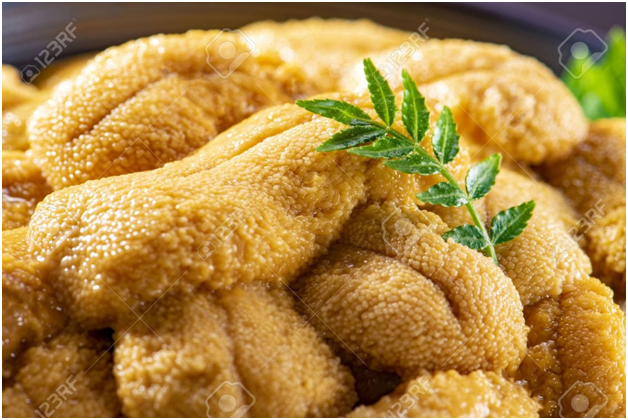Uni sea urchin spend their lives feeding off sea kelp and other seaweeds. These seaweeds are rich in vitamins and minerals. Sea urchin uni is loaded with:
o protein
o beta carotene,
o zinc
o omega-3 fatty acids
o dietary fiber
Sea urchin is also rich in vitamins A and C.
Sea urchin is low on the food chain and is a low mercury seafood!
Japanese folklore elevates uni sea urchinuni to a powerful aphrodisiac.
Sea urchins are marine invertebrates that typically live on the bottom of the seafloor.
They come in a variety of colors.
They can be found in all of the world’s oceans from deep waters to polar waters, tropical
reefs, kelp forests, and seagrass beds.
They have a globular outer skeleton called a test with hundreds of movable spines, tube
feet, and tiny pincer like organs.
Their tube feet extend through tiny pores on their test.
The tube feet are tipped with suckers that help them to cling to objects, move, and remove
unwanted debris.
The tiny pincers also help to clear unwanted materials.
The spines are attached to nodules on their test.
Sea urchins are highly vulnerable to predation so they count on their spines to deter predators.
They may also use their spines to walk.
Their digestive and reproductive organs are located inside their skeleton.
They usually have slender sharp spines or massive blunt spines.
The spines may be long, thin, short, or stubby.
Each species usually has more than one type of spine.
You can pick up most sea urchins without getting harmed.
However, some have sharp venomous spines that can cause painful puncture wounds.
Their spherical skeletons are formed from fused plates.
Because of their symmetrical shape the true sea urchins being described in this video
are referred to as regular urchins, unlike their irregular relatives the heart urchins,
sand dollars, and sea biscuits.
A sea urchin’s mouth is located on its underside.
They eat with a structure called Aristotle’s lantern.
It is equipped with 5 hard plates that come together like a beak.
They can use these plates to scrape algae off surfaces and to attack and eat other organisms
likemolluscs and tube worms.
Some even use their teeth to bore into solid rock, creating a crevice to live in.
Sea urchin spines provide protection for a number of small animals like shrimp and juvenile
fish.
To reproduce, in most species, male and female urchins simultaneously emit sperm or eggs
into the water.
Fertilized eggs hatch into larvae that drift with the current before developing into juvenile
urchins and settling on the bottom.
Some deep sea and some cold-water species skip their larval stage.
Adult sea urchins typically grow between 1 and 4 inches (2.54 to 10 cm) wide, but some
species are much larger.
Sea urchins can be vital in controlling algae on reefs.
Too much algae can block corals from getting adequate sunlight.
Predators like sea otters, sea stars, snails, and some fish and like to prey on sea urchins.
In areas without enough predators, the sea urchin population can explode.
With their constant grazing, overpopulated sea urchins can be devastating to kelp forests.
Kelp provides habitat for many sea animals.
On the other hand, sea urchins are messy eaters and the bits of kelp that they shred but don’t
consume become food for detritivores.
In some cultures, The gonads of sea urchins are considered a delicacy.
They can be eaten raw, cooked, or dried.












